Building great brands isn't a fortunate accident—it's a deliberate process involving thoughtfully curating experiences and creating meaningful connections with people. The most successful brands don't just happen to stand out; they're designed to be memorable, to resonate with their audience, and to grow stronger over time. These brands are easy to recognize and become a trusted part of the consumer's life.
But what sets these brands apart from the rest? How do they manage to stay consistent while adapting to the ever-changing market?
The answer lies in the foundation they build—a set of clear, actionable guidelines that define who they are and how they show up.
In the marketing world, these are called brand guidelines. Let's understand how it comes into play while crafting the brand.
What are Brand Guidelines?
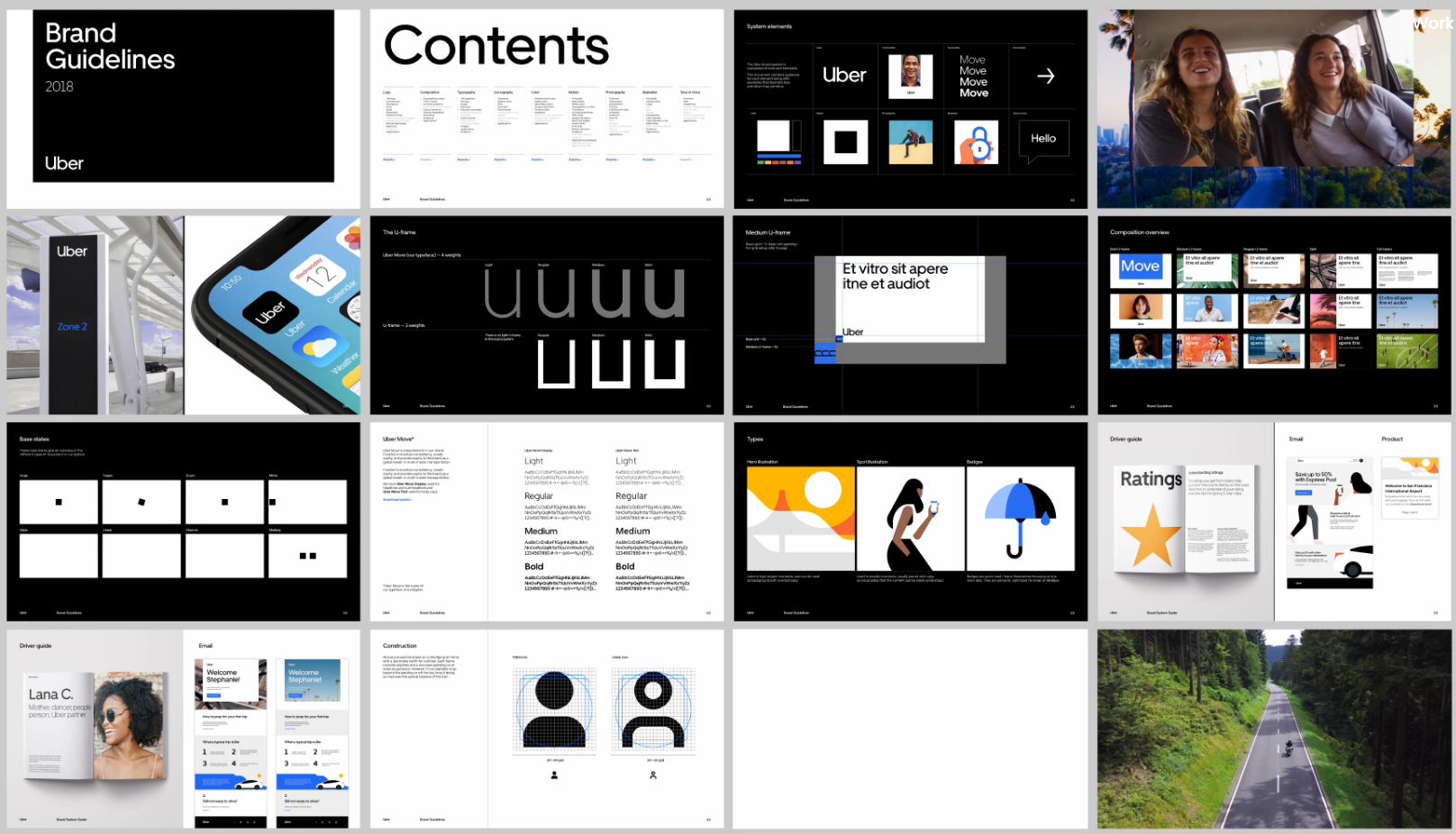
Brand guidelines are the roadmap for maintaining consistency in how your brand appears. Also known as a brand style guide, they set the rules for everything from your color palette and fonts to the overall style and tone of your messaging. Brand guidelines ensure that no matter where or how someone interacts with your brand, the experience is always cohesive and true to who you are.
The brand guidelines incorporate the brand's vision, mission, and values and ensure that marketing activities follow the guidelines, resulting in easy brand recognition.
Therefore, crafting the brand guidelines is as important as crafting your brand.
Why are brand guidelines important for your business?
1. Establishing a strong brand identity
Your brand identity is more than just a logo or a tagline—it's the complete picture of how your brand presents itself to the world. Think of it as the personality of your business. Consistent use of brand guidelines means that every visual and message aligns with that personality. This kind of alignment helps your brand become instantly recognizable.
And when people recognize your brand, they're more likely to trust it. Over time, this trust builds loyalty.
Legacy brands like IBM in technology, Honda in the automobile industry, etc., have indomitable trust in their respective industries and have evolved with the market needs to gain loyal followers who trust the brand to innovate as the world progresses. They choose the brand every time.
2. Standing out in a competitive market
In a world where consumers are constantly bombarded with choices, how do you ensure your brand doesn't get lost in the crowd? A key way is through consistency. When your brand's visual identity and messaging are always on point, it becomes easier for people to remember and relate to it.
Consistent branding helps you carve out a unique space in the market, which is critical when competing for attention in a busy landscape. By sticking to your brand guidelines, you're sending a clear, confident message about who you are and what you stand for.

Remember this space jump by Red Bull?
The brand associates the energy drink with daring stunts, giving the perception that the drink can give you the energy to do anything! In a crowded energy drink market, RedBull stands out with this perception.
3. Securing the mindshare of consumers
Brand guidelines play a crucial role in securing the mindshare of consumers. When consumers see the same visual cues and hear the same brand voice over and over, it becomes second nature to associate those elements with your brand.
Here’s an example of Apple driving its privacy-first approach.
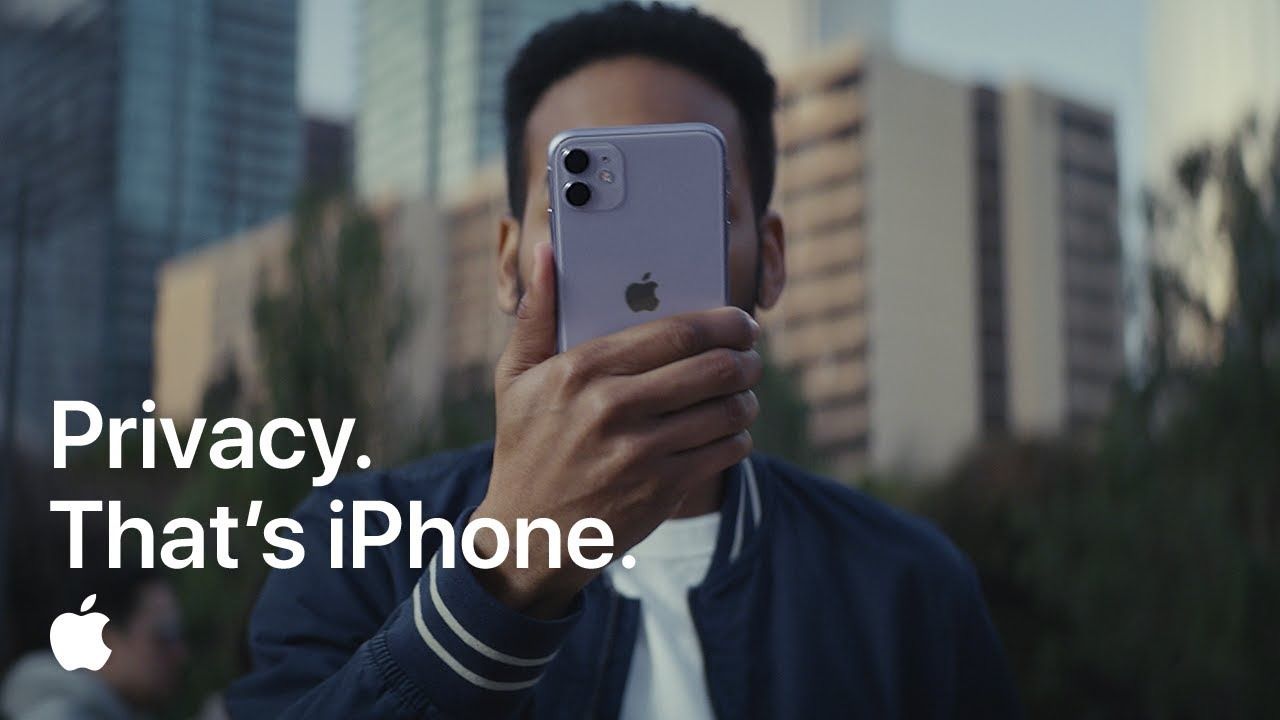
This consistency creates brand recognition, which translates into mindshare. Next time someone thinks of buying a phone with privacy as a priority, apple’s brand stands out with this direct messaging.
The more space you occupy in your audience's mind, the more likely they are to choose your brand when they're ready to make a purchase.
4. Streamlining internal and external communication
Brand guidelines make life easier for your internal teams and external partners. With a solid set of rules, everyone involved in creating brand materials—from marketing to design to sales—knows how to represent the brand. This eliminates guesswork, reduces the risk of off-brand content, and speeds up decision-making. Whether it's an internal presentation or a public-facing campaign, brand guidelines ensure everyone is on the same page.
5. Ensuring long-term brand success
Brands evolve over time, but with clear guidelines, they can evolve in a way that maintains their core identity. Brand guidelines allow for flexibility while keeping the essence of the brand intact, ensuring that as your brand grows or expands into new markets, it remains recognizable and true to its origins. This provides a stable foundation for consistent and sustainable growth for the brand’s success.
Crafting your brand guidelines involves logically combining multiple brand components to achieve the desired brand recognition.
Now that we've explored why brand guidelines are so important let's dive into what they actually include.
What to include in your brand guidelines?
A solid brand guideline keeps your brand consistent across everything—from marketing materials to digital platforms. Below are the key brand components that form the backbone of effective brand guidelines. In the process section, we'll explain how to create and implement each.
- Mission and Values This is the center of your brand's story, outlining the core mission and values that drive your brand. It defines why your brand exists and what it stands for, serving as a guiding principle for every decision, communication, and action your brand takes. A clear mission and values ensure that your brand stays aligned with its internal and external purpose.
- Logo Usage: Your logo is the face of your brand, so it's important to use it right. The logo usage guideline defines how and where your logo can be used, including different variations, clear space, and minimum sizes to maintain brand integrity. These directions come in handy for both internal and external teams when the logo needs to be placed across multiple marketing collaterals.
- Color Palette: The color palette represents your brand colors and their acceptable variations. This generally includes primary and secondary colors representing your brand and guides the reader on applying them across various media.
- Imagery Imagery sets the standards for the types of photos, illustrations, and visual content used across brand touchpoints. By defining a consistent style, it ensures that all visual elements reflect your brand's aesthetic and resonate with your audience.
- Brand Voice and Tone This component defines how your brand communicates with its audience, focusing on the language's style, tone, and personality. What kind of language do you use? Are you casual, formal, witty? The voice and tone guide ensures your brand sounds the same across the board—whether you're writing an email, a blog post, or a tweet. It's about consistency in personality and communication.
- Brand Applications Brand applications provide practical examples of implementing the brand's visual and messaging elements across different platforms. This includes guidelines for websites, social media, print materials, outdoor marketing collateral, signages, signatures, etc, ensuring a unified look and feel. You can add as many examples as possible to give clear guidelines to external stakeholders and ensure the creatives meet brand standards
- Design Elements Design elements cover any additional visual features, such as patterns, shapes, and graphical details that are unique to your brand. These elements help create a distinct brand identity and contribute to a cohesive visual presence.
- Trademark Usage Brand guidelines should include rules around the correct usage of registered trademarks, logos, taglines, and other proprietary elements. This section helps protect your brand's legal integrity by specifying how to use (and not use) these assets. It's about protecting your brand's identity, ensuring your assets are used correctly, and avoiding legal or branding issues, especially when third parties are involved.
These components act as the building blocks of the brand guidelines. They are created using a methodical approach to align with the brand.
How do you create brand guidelines?
Creating brand guidelines involves laying a strong foundation that ensures consistency across all brand touchpoints. This process involves defining key elements like your logo, voice, and color palette while aligning with your brand's values and target audience.
Let's take a look at a detailed process to build your brand's guidelines and the key sections to add to them.
1. Define and add brand foundations as the first chapter
Before delving into the brand components, it's paramount to establish the core elements that shape your brand's identity. The first step is to brainstorm your core brand values—the guiding principles underpinning every decision, from marketing strategies to customer interactions. What does your brand stand for? Is it innovation, integrity, or customer-centricity?
These brand values will shape your internal operations and influence how your audience perceives you.
Once your values are clear, define the emotion behind your brand's recognition. This goes beyond logos and taglines. Do you want to be known as cutting-edge and forward-thinking or as a reliable and trustworthy staple in your industry?
Being intentional here will set the stage for all your branding efforts.
Next, dig into what your brand stands for. This is where you narrow down your brand's purpose. What problem are you solving for your customers? What's your reason for existing beyond just making a profit? This reflection helps clarify your brand's role in the world and builds an emotional connection with your audience.
Putting all this together, articulate your vision and mission statements. Your mission statement is about the here and now—what your brand does and how it serves its customers today. Your vision statement looks toward the future, defining your brand's aspirations in 5, 10, or 20 years.
Together, these statements anchor your brand and give it directions to the other components that we will see in the coming sections.
Key takeaway:
In the brand guidelines, define your brand’s core values, purpose, and long-term goals based on the abovementioned process. These help the reader get a clear picture of how to think about your brand. This will be the opening section of your brand guidelines.
2. Bring alignment among all the stakeholders
To create effective brand guidelines, it is essential to bring key stakeholders together for a collaborative output. This can be done with the help of regular brainstorming sessions and workshops, as these sessions allow team members from marketing, design, leadership, and even product development to align on the brand’s direction. Everyone brings a unique perspective, and these diverse insights are critical to ensuring the brand guidelines are both visionary and practical.
Start with a brainstorming session where everyone can share ideas on the brand’s values, tone, and personality. Encourage open dialogue to capture different viewpoints. Follow this up with mood boarding, a process where teams collectively gather visuals, textures, and styles that resonate with the brand identity they want to project. This not only helps create a visual reference point but also makes the teams feel more connected to the brand’s look and feel. Workshops can also effectively align teams on messaging, visuals, and positioning.
Structure these sessions using the mission and vision statements created to keep the focus intact. These can be used to refine ideas, decide on key components like color palettes, typography, and brand voice, and test how different ideas resonate with stakeholders.
Key takeaway:
Bringing stakeholders together fosters collaboration and ensures alignment from the outset. You can gain constant feedback through brainstorming, workshops, and creative tools like mood boards and nail the brand guidelines that reflect your brand.
3. Craft your brand logo and its usage.
Designing a brand logo is both an art and a science. The logo is often the first thing people will notice, so it has to be memorable, versatile, and true to what your brand stands for. The goal isn’t just to create something visually appealing but to capture the essence of your brand in a single, powerful mark.
Start with concept development. Before diving into design software, sketch several ideas based on your brand’s core values and positioning. A logo should communicate a clear message, so spend time on ideation—ask yourself, what does this logo need to say?
This is where techniques like symbolism and negative space come into play. Some of the most iconic logos incorporate clever use of symbols or negative space to reinforce brand messaging in a subtle yet impactful way.
Next, focus on form and shape psychology. Different shapes convey different emotions—circles often communicate unity and harmony, while angular shapes like triangles can suggest dynamism and innovation. Think about what fits your brand best and what kind of feeling you want your audience to get from just seeing the logo.
Once you have crafted the logo, add the usage guidelines. They should include the do’s and don’ts of logo usage, acceptable position variations, and color variations that will help anyone using the logo represent your brand in the right way.
Here’s clickup.com explaining how to use their logo. Notice the examples that give direction on the usage.
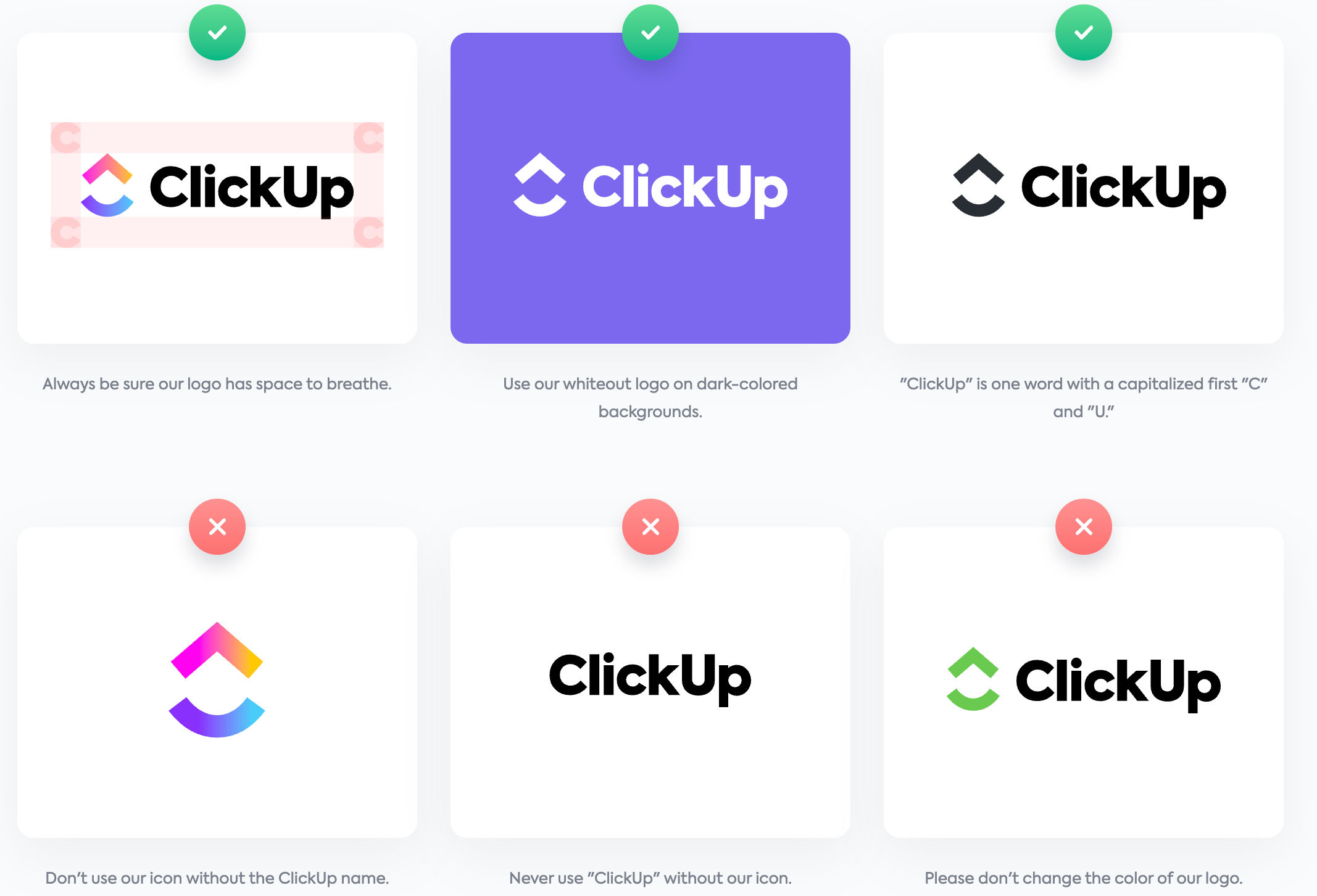
Key sections to add to your brand guidelines:
- Logo Do’s and Don’ts
- Logo color variations with examples
- Ready to download logo variations
- Logo positioning variations with examples
4. Establish a color palette
Creating a color palette is crucial to defining your brand's identity. Colors aren't just aesthetic choices—they evoke emotions and can influence how your audience feels about your brand. The key is to strike a balance between representing your brand's personality and ensuring versatility across all mediums.
Start by selecting primary colors that reflect your core values. Think about the psychology behind each color: blues convey trust and professionalism, while greens are often linked to health or sustainability.
Once your primary colors are locked in, add secondary colors that complement the core palette without overpowering it. These will help add depth and flexibility to your design, allowing for variation while maintaining consistency.
It's also crucial to test your palette for accessibility and readability. This step ensures that your colors work well in both digital and print formats, and always consider contrast to ensure legibility.
The color palette guidelines should showcase the usage of colors across multiple platforms and the acceptable shades of primary and secondary colors. Defining the color codes in the brand guidelines will use the right colors and establish brand consistency.
Here’s a solid example of Slack showcasing its primary colors and the permissible color combinations in its guidelines
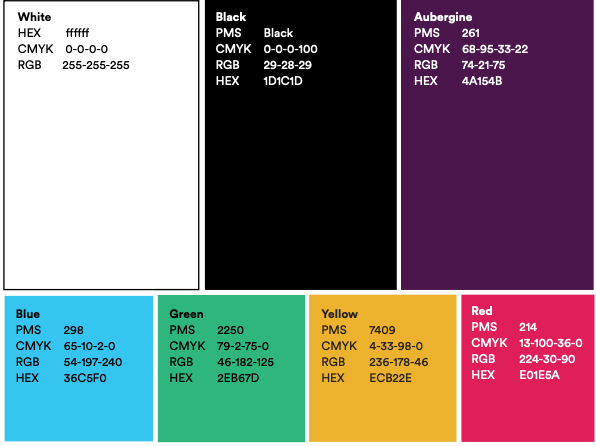

Key sections to add to your brand guidelines:
- Primary colors with example shades
- Secondary colors with example shades
- Permissible color combinations
5. Add brand typography details
Choosing the right typography is more than just picking a font—it’s about visually representing your brand’s personality. Depending on their style, fonts can communicate authority, creativity, or approachability. The goal is to choose a font that aligns with your brand’s tone while ensuring readability across all platforms.
Start by selecting a primary typeface for your brand’s main communications. Whether a modern sans-serif like Helvetica or a more formal serif like Times New Roman, the font you choose must fit your industry and message; complement this with a secondary typeface for headings or emphasis, making sure the two work well together. Pay attention to details like kerning (the space between letters) and leading (the space between lines), as they affect both readability and aesthetics.
Here’s an example from Miro’s brand kit that defines a clear usage guideline for their brand typography, Roberto Pro. The guideline further showcases how to use the font for different purposes, like headlines, body copy, etc., which ensures consistency across any marketing collateral created.

Key sections to add to your brand guidelines:
- Font family
- Font variations in Blod, italic
- Font Spacing
- Type - Size relationship
- Example usage
6. Brand tone and voice
Your brand's tone and voice are vital for conveying your brand's personality, values, and purpose. The voice is the constant personality of your brand—whether it's authoritative, friendly, or playful. The tone can shift depending on context, allowing for flexibility in how you communicate. Think of voice as "who" your brand is, and tone as "how" it speaks in different situations.
To develop a strong brand voice, start by considering your core values. Ask yourself, "How should our brand come across? Should we be conversational and approachable, or formal and professional?"
Once established, your voice should stay consistent across all touchpoints—from social media posts to customer service interactions. When defining tone, build out guidelines for flexibility.
For example, you might use a more playful tone for marketing campaigns but adopt a formal tone for reports or crisis communications.
Similar to the guideline you choose to craft, a voice and tone matrix can be highly effective. This matrix outlines different scenarios (e.g., email campaigns, social media, press releases) and defines the appropriate tone to be used in each, ensuring consistency across the board.
The easier way to achieve this is by adding examples of tone usage in your brand guidelines to give a clear direction on representing your brand. Here’s how Duolingo does this:
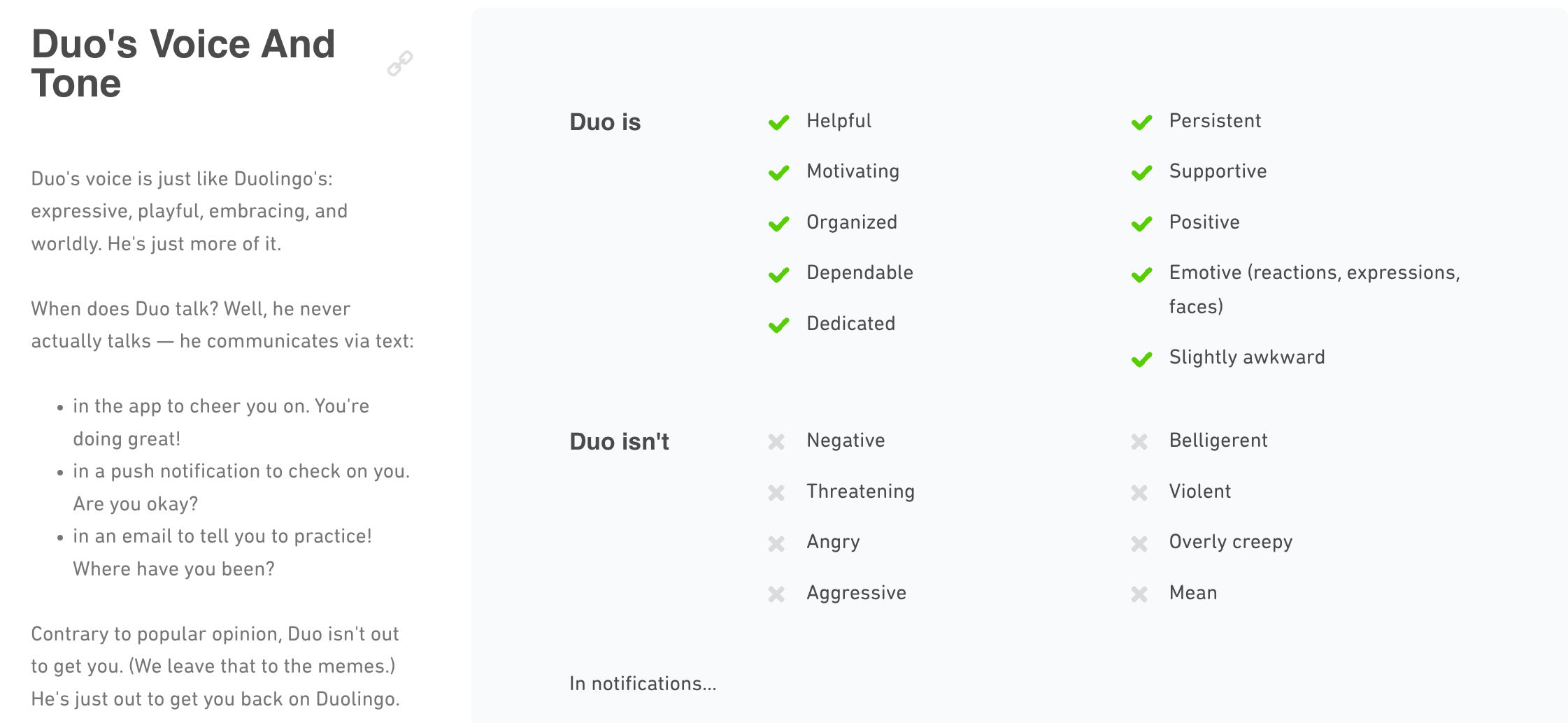
If you are looking to create a detailed guide on tone and voice, Here’s mailchip content style guide as a reference.
Key sections to add to your brand guidelines:
- Voice and tone guide
- Dos and don'ts of brand writing
- Writing for different platforms with examples
7. Set Imagery guidelines
Imagery plays a critical role in shaping a brand’s identity and connecting emotionally with the audience. The goal is to create a consistent visual language that resonates with your brand’s values and enhances the overall user experience.
Whether you’re using photography, illustrations, or icons, every image should tell part of your brand’s story.
Start by determining the style of imagery that best suits your brand. For instance, tech companies often lean towards sleek, minimalistic images with high contrast, while lifestyle brands may opt for warm, natural photography that feels more organic. For technical consistency, develop rules around resolution (high-quality images for both digital and print), color grading (warm vs. cool tones), and composition (close-ups, landscapes, or balanced whitespace). These details ensure that your imagery maintains a cohesive look no matter where it is used.
Also, consider creating a library of brand-approved images. This gives your team easy access to visuals that align with your brand guidelines, preventing off-brand imagery from slipping into your materials. Include specifications on how to edit photos, use filters, or apply overlays that enhance your visual storytelling.
When using icons or illustrations, consistency in line weight, color, and style is essential. A mismatch of styles across platforms can make the brand feel disjointed. Additionally, ensure that any infographics or data visuals use the correct color palette and fonts to maintain the brand’s identity, even in more technical contexts.
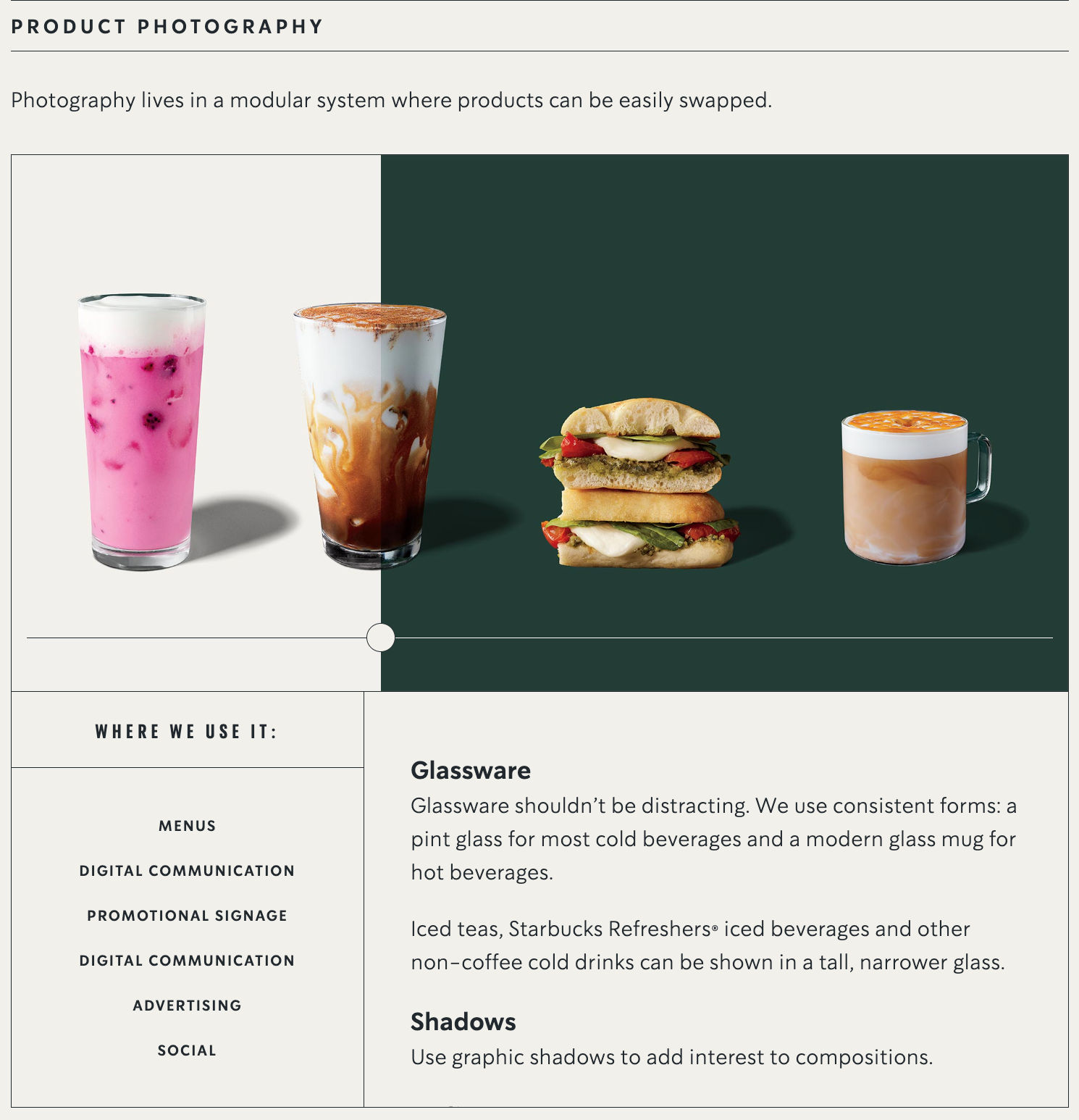
Starbucks’s brand guidelines offer an extensive deep dive into the imagery rules they have for images for different collaterals like menus, digital communication, social advertising, etc., giving a clear sense of direction for the type of image and channel.
If you rely heavily on video content, you can create a similar section for video in your brand guidelines and set standards with examples.
Key sections to add to your brand guidelines:
- Image resolutions with examples
- Image compositions
- Approved images to download
- Channels and images examples
8. Add governance and trademark details in the guidelines
A comprehensive brand usage guideline ensures that your brand is represented consistently across all touchpoints, whether it's internal teams or external partners working with your brand assets. These guidelines cover everything from logo placement and color palette to tone of voice and messaging.
Within these guidelines, there are two key areas that require special attention: governance and trademarks.
Governance
Brand governance is the framework for ensuring all branding efforts align with the established guidelines. A brand manager or the branding team is responsible for reviewing all materials and maintaining such a framework. You can also add details like permitted usage in the governance section of the guide to ensure consistency.
Trademarks
Trademark usage is a critical part of your brand usage guideline. This section sets the rules for how registered trademarks, logos, taglines, and proprietary symbols can and cannot be used. It is important to specify the legal restrictions around your brand assets, including size requirements, placement rules, and how third parties should refer to your brand in writing or visuals.
It is worth mentioning that almost all brands keep their legal team involved in the process of creating the governance and trademark section of the brand guidelines.
Key sections to add to your brand guidelines
- Governance section
- Trademark section with countries it is applicable.
- Examples of what to be avoided
9. Reviewing feedback and responses from the market
Once your brand is out in the world, reviewing feedback and how the market responds to it continuously is crucial. Monitoring social media comments, customer reviews, and industry feedback gives you valuable insights into how your brand is being perceived. Are people resonating with your message? Are they interacting with your brand the way you intended? Use tools like Google Analytics, social listening platforms, and surveys to gather data.
Regularly reviewing this feedback helps you refine your brand guidelines and help create a document that will push you forward to achieve the desired brand recognition.
21 Brand guidelines examples PDFs to inspire you
Looking for inspiration to create your own brand guidelines?
We’ve got you covered! Here are 21 great examples of brand guidelines in PDF format that showcase how different companies present their brand’s identity. These examples will give you insight into how to structure and design your own.
But before we proceed, we know what’s on your mind!
Why PDFs are the best way to present your brand guidelines?
- They are easy to share and distribute: PDFs are simple to email, upload, or share via links, ensuring everyone can access the same file.
- Consistent formatting: PDFs maintain their design and layout across all devices, meaning your brand guidelines look exactly as intended, whether viewed on a phone, tablet, or computer.
- Universal accessibility: Almost all devices and platforms can open PDFs, eliminating compatibility issues.
- Offline availability: Once downloaded, PDFs can be accessed without an internet connection.
Why a digital asset management (DAM) system is the key to maintaining brand guidelines
While brand guidelines guide your creatives, keeping these creatives in line on an operational level can be difficult. Managing these assets can quickly get tricky with multiple stakeholders and different types of creatives being created across multiple channels. This is when you need a digital asset management tool like ImageKit.
Let's take a quick sneak peek into the challenges:
- Inconsistent use of assets: Without a central source of truth, teams may use outdated logos or graphics. A DAM like ImageKit ensures everyone has access to your assets' latest, approved version.
- Difficulty in asset management: Keeping track of all assets across multiple platforms can be overwhelming. With ImageKit, you can organize files in a central storage using custom metadata (to organize your assets the way you want), AI tags, and media collections, making locating specific assets in seconds easy.
- Slow approval processes: Long feedback loops can slow down creative output. ImageKit streamlines collaboration with real-time feedback, comments, and audit logs, ensuring faster approvals and better project oversight.
- Difficulty in securely sharing assets: Sharing brand assets internally and externally can be risky without the right controls. ImageKit allows for public sharing links with password protection and access controls, ensuring assets are securely distributed without compromising their integrity.
To sum up, a DAM ensures that your brand’s visual identity remains cohesive, scalable, and secure. With these challenges addressed, you're now well-equipped to create comprehensive brand guidelines and maintain them efficiently, ensuring long-term success for your brand.
Ready to ensure your brand remains consistent and organized? Try ImageKit today and see the difference it can make!
Wrapping it up
Well, if you’ve read this far, we are pretty sure you have a clear picture of how to build your brand guidelines.
Let’s do a quick recap; in this guide, we’ve walked through the entire process of building a brand guideline—from understanding its importance to breaking down the essential sections it must include. We explored how iconic brands manage their identity and set up your roadmap for creating a comprehensive guide.
It is now your turn to put these pieces of information together and build your own brand guidelines.




